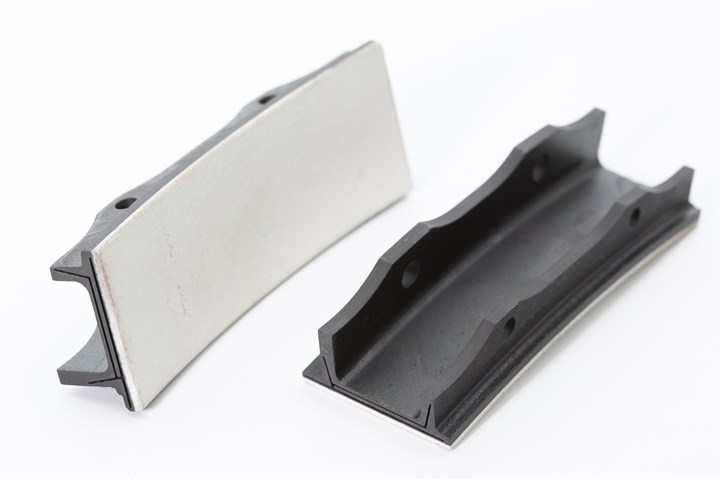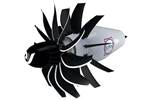GE Aviation reaches advanced manufacturing milestone for CMC and AM jet engine components
This past July, two sites, Asheville, N.C., and Auburn, Ala., shipped their 100,000th CMC turbine shroud and 100,000th additively manufactured fuel nozzle tip respectively.

CMC turbine shrouder components. Photo Credit: GE Aviation
Two GE Aviation (Cincinnati, Ohio, U.S.) facilities producing advanced jet engine components recently passed major manufacturing milestones, according to a company announcement on Aug. 11. GE Aviation’s Asheville, N.C., facility recently shipped its 100,000th turbine shroud made from ceramic matrix composite (CMC) materials, while the Auburn, Ala., facility recently shipped its 100,000th additively manufactured fuel nozzle tip.
The Asheville facility (see CW’s 2017 tour, “GE Aviation's CMC parts facility in Asheville, NC”), which began producing CMC in 2014, is reported to be the aviation industry’s first mass manufacturing site for jet engine components made from CMC. The Auburn site began producing fuel nozzles in 2015 and, according to GE Aviation, was the industry’s first mass manufacturing site for producing aircraft engine parts using additive manufacturing (AM).
Both parts are made for the CFM LEAP engine (LEAP engines are a product of CFM International, a 50/50 joint company between GE and Safran Aircraft Engines), which entered revenue service in 2016 and surpassed 10 million flight hours earlier this year. The fleet is said to be providing operators with 15% better fuel efficiency than previous generation engines. Each engine has 18 shrouds and 18 or 19 fuel nozzles, depending on the specific model.
In Asheville and Auburn, GE Aviation employees helped establish new processes to mass produce parts with CMC materials and additive methods, then scaled the technology over time, while improving and maintaining production quality.

Asheville, N.C. facility. Photo Credit: GE Aviation.
“We're proud to deliver our 100,000th CMC turbine shroud in support of the LEAP engine,” says Ed Orear, composites general manager for GE Aviation. “This milestone is a testament to GE Aviation’s commitment to produce the leading aviation materials technologies. This achievement could not have happened without the production teams in Asheville and Huntsville, supported by GE’s engineering teams at GE Aviation and GE Research.”
GE Aviation employees in Huntsville, Ala., support high-volume, raw material production of CMC.
CMC, an advanced material containing silicon carbide fibers, is one-third the weight of traditional metal alloys with two times the temperature capability, helping improve engine thermal efficiency, thus reducing fuel consumption and carbon emissions.
Alternately, AM involves using computer-aided designs to “print” a metal part from powder, layer by layer. Unlike traditional manufacturing methods that mill or cut away from a slab of metal to produce a part, AM (or 3D printing) grows parts directly from a CAD file using layers of fine metal powder and an electron beam or laser. The resulting part is lighter weight with less waste, manufactured in a fraction of the time it would take using traditional methods.
“We opened the industry’s first site for mass production using the additive manufacturing process, and to achieve this milestone affirms our plans and investments were on target,” says Eric Gatlin, additive general manager for GE Aviation. “There is a bright and exciting future for this technology.”
Related Content
-
Composites manufacturing for general aviation aircraft
General aviation, certified and experimental, has increasingly embraced composites over the decades, a path further driven by leveraged innovation in materials and processes and the evolving AAM market.
-
Plant tour: Spirit AeroSystems, Belfast, Northern Ireland, U.K.
Purpose-built facility employs resin transfer infusion (RTI) and assembly technology to manufacture today’s composite A220 wings, and prepares for future new programs and production ramp-ups.
-
Manufacturing the MFFD thermoplastic composite fuselage
Demonstrator’s upper, lower shells and assembly prove materials and new processes for lighter, cheaper and more sustainable high-rate future aircraft.















